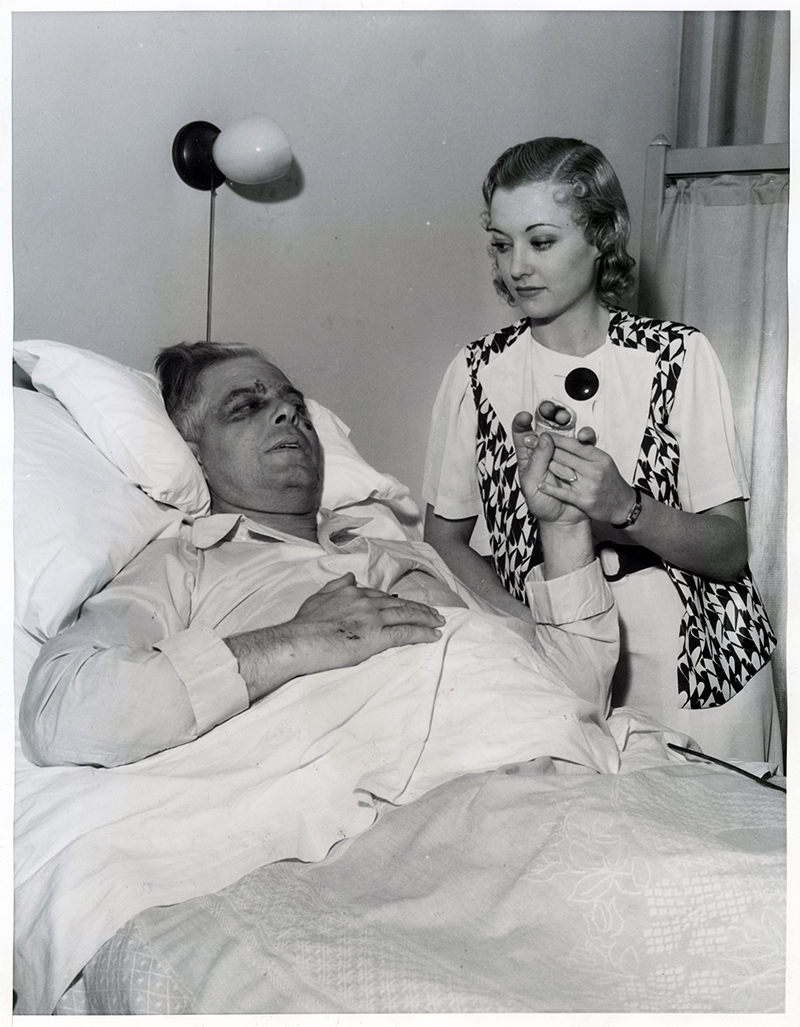Photo shows actress June Gale at Hoot Gibson's bedside in Cedars of Lebanon hospital (now Cedars-Sinai) on July 8, 1933, as the Western film star recovers from injuries he sustained when he crashed his plane during an air race with fellow actor Ken Maynard.
Gale was Gibson's constant companion during the latter's separation from his (third) wife, Sally Eilers, which Eilers had disclosed more than a year earlier (May 1932) when she was involved in a car crash.
Eilers obtained a divorce in late August 1933, less than two months
after this photograph appeared in newspapers.
7x9-inch Associated Press photo. Cutline reads:
HOOT'S ON ROAD TO RECOVERY
Hoot Gibson, cowboy-flier of the films, who cracked up while racing in a special match against Ken Maynard, another Hollywood broncho-riding pilot, in the
National Air Races, is recovering from his injuries at the Cedars of Lebanon hospital, and June Gale, actress and his companion at film social events, has been visiting
his bedside. His wife, Sally Eilers, motion picture star, from whom Gibson has been reported estranged, is in Europe.
dd-7/8/33
There was speculation that Gibson would make Gale his fourth wife, but he didn't. That distinction went (in 1942) to a 22-year-old yodeler named Dorothea Dunstan, who stayed with him until his death 20 years later.
Edmund Richard Gibson earned the nickname "Hoot" when he worked as a messenger for the Owl Drug Co.
He was born August 6, 1892, in Tekamah, Nebraska and appeared in more than 200 films (including short
features) between 1910, when he earned $50 for his role in "The Two Brothers," and
1960, when he made an uncredited appearance in "Ocean's Eleven." Gibson did
most of his work as a silent cowboy actor between World War I and the early 1930s. He directed a bit
in 1920-21 and produced some of his own films from 1923-30. The 5'9" Hollywood giant died of
cancer on August 23, 1962, in Woodland Hills — five days before a wildfire burned down
Gene Autry's Melody Ranch in Placerita Canyon, where Gibson made some of his movies.
In addition to using the Santa Clarita Valley as a backdrop for filming, during the time he was
married to Dorothea Sally Eilers (a popular leading lady in late
silents and early talkies), he owned a ranch in Saugus now known as the Saugus Speedway. SCV historian
Jerry Reynolds writes:
"Roy Baker purchased a 40-acre tract east of Bouquet Junction during 1923, starting construction on
a rodeo arena a year later. Hoot Gibson bought the ranch and stadium in 1930, putting on shows that attracted
such stars as Tom Mix, John Wayne and Clark Gable. In 1934 Gibson sold out to Paul Hill, who ran the
Western Livestock yards and leased it to film companies for three years until a huge flood filled the home
and arena with mud and debris. (Hill) was unable to make payments, and the bank repossessed the property,
which was eventually taken over by a professor of economics at Occidental College, William Bonelli (who
started the Santa Clarita Water Co. and built one of the first local housing tracts in the late 1940s).
Today (the rodeo arena) is known as the Saugus Speedway."
LW3012: 9600 dpi jpeg from original photograph purchased 2017 by Leon Worden.








